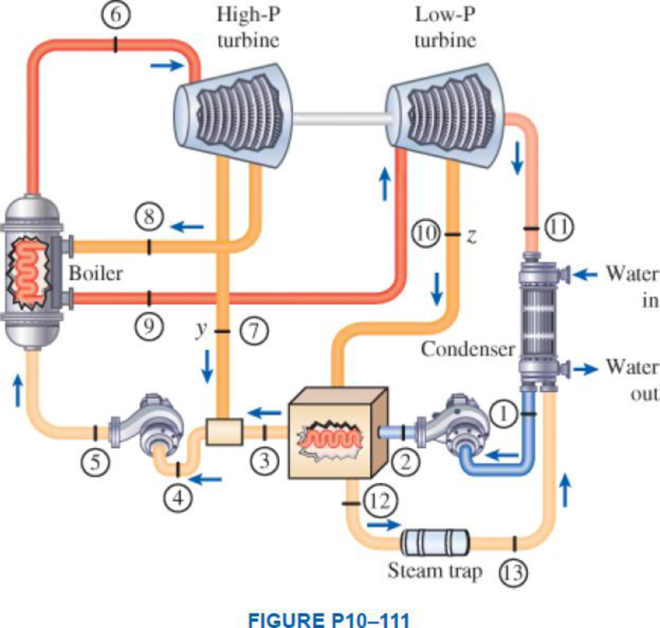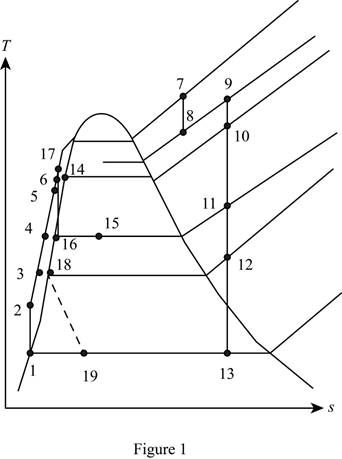
A Rankine steam cycle modified for reheat, a closed feedwater heater, and an open feedwater heater is shown below. The high-pressure turbine receives 100 kg/s of steam from the steam boiler. The feedwater heater exit states for the boiler feedwater and the condensed steam are the normally assumed ideal states. The following data tables give the saturation data for the pressures and data for h and s at selected states. (a) Sketch the T-s diagram for the ideal cycle. (b) Determine the net power output of the cycle, in MW. (c) If cooling water is available at 25°C, what is the minimum flow rate of the cooling water required for the ideal cycle, in kg/s? Take cp,water = 4.18 kJ/kg·K.
| Process states and selected data | ||||
| State | P, kPa | T, °C | h, kJ/kg | s, kJ/kg·K |
| 1 | 20 | |||
| 2 | 1400 | |||
| 3 | 1400 | |||
| 4 | 1400 | |||
| 5 | 5000 | |||
| 6 | 5000 | 700 | 3894 | 7.504 |
| 7 | 1400 | 3400 | 7.504 | |
| 8 | 1200 | 3349 | 7.504 | |
| 9 | 1200 | 600 | 3692 | 7.938 |
| 10 | 245 | 3154 | 7.938 | |
| 11 | 20 | 2620 | 7.938 | |

(a)
Sketch the T-s diagram for the ideal cycle.
Answer to Problem 111RP
Sketch the T-s diagram for the ideal cycle is shown in Figure 1.
Explanation of Solution
Draw the
Figure 1.

(b)
The net power output of the cycle.
Answer to Problem 111RP
The net power output of the cycle is
Explanation of Solution
Write the formula for work done by the pump during process 1-2.
Here, the specific volume is
Write the formula for enthalpy
Write the formula for work done by the pump during process 3-4.
Here, the specific volume is
Write the formula for enthalpy
Write the formula for an energy balance on the open feed water heater.
Here, the fraction of steam extracted is
Rewrite the Equation (V) to find out the value of
Write the formula for an energy balance on the closed feed water heater.
Here, the fraction of steam extracted is
Rewrite the Equation (V) to find out the value of
Write the formula for heat input in the boiler.
Write the formula for work output from the turbine.
Write the formula for net work output from the cycle.
Write the net power output of the cycle.
Conclusion:
From the Table A-5, “Saturated water-temperature Table” obtains the value of the enthalpy
Substitute
Substitute
From the Table A-5, “Saturated water-temperature Table” obtains the value of the enthalpy
Substitute
Substitute
Refer Table A-5, “Saturated water-temperature Table”, and write the enthalpy at state 12 at pressure of
Here, enthalpy of saturation liquid at pressure of
Write the formula of interpolation method of two variables.
Here, the variables denote by x and y is pressure and specific enthalpy at state 12 respectively.
Show the specific enthalpy at state 12 corresponding to temperature as in Table (1).
|
Pressure at state 12 |
Specific enthalpy at state 12 |
| 225 | 520.71 |
| 245 | |
| 250 | 535.35 |
Substitute
Substitute
Here, the throttle valve operation of specific enthalpy at the state 13 is equal to specific enthalpy at the state 12.
Substitute
Substitute
Substitute
Substitute
Substitute
Substitute
Thus, the net power output of the cycle is
(c)
The minimum flow rate of the cooling water.
Answer to Problem 111RP
The minimum flow rate of the cooling water is
Explanation of Solution
Write the formula for heat rejected from the condenser.
The mass flow rate cooling water will be minimum when the cooling water exit temperature is a maximum as
Write the formula for an energy balance on the condenser.
Conclusion:
Substitute 0.1039 for
Substitute
Thus, the minimum flow rate of the cooling water is
Want to see more full solutions like this?
Chapter 10 Solutions
THERMODYNAMICS: AN ENGINEERING APPROACH
- A steam power plant operates according to the reheat Rankine cycle between the pressure limits of 15 MPa and 10 kPa. The mass flow rate of the steam circulating in the cycle is 12 kg/s. The steam enters both stages of the turbine at a temperature of 500 °C. The dryness fraction of the steam at the exit of the low-pressure turbine is 90%. Show the cycle on a T-s diagram, including the saturated liquid and saturated vapor lines. Also, determine: a) The pressure at which reheat occurs, b) The amount of heat supplied to the steam per unit time in the boiler, c) The thermal efficiency of the cycle. Note: This is a question from the thermodynamics course. Please provide a clear and quick solution.arrow_forwardIn a steam power plant that operates based on a Rankine cycle, the operating pressures of the steam generator and the condenser are 10,000 and 10 kPa, respectively. If the turbine inlet stream is saturated vapor and the condenser outlet flow is saturated liquid, determine the specific heat transfers in the steam generator and the condenser, the specific work involved in the turbine and the pump, and the thermal efficiency and the BWR of the cycle. Also, if the power plant produces 250 MW power, determine the mass flow rate of the cycle’s working fluid.arrow_forwardSteam enters the turbine of a simple vapor power plant with a pressure of 12 MPa and a temperature of 600°C and expands adiabatically to condenser pressure, p. Saturated liquid exits the condenser at pressure p. The isentropic efficiency of both the turbine and the pump is 84%. a. For p = 30 kPa, determine the turbine exit quality and the cycle thermal efficiency. b. Plot the quantities of part (a) versus p ranging from 6 kPa to 100 kPa.arrow_forward
- A steam power plant operates on the ideal reheat Rankine cycle. Steam enters the high-pressure turbine at 6 MPa and 400C and leaves at 2 MPa. Steam is then reheated at constant pressure to 400C before it expands to 20 kPa in the low-pressure turbine. Determine the turbine work output, in kJ/kg, and the thermal efficiency of the cycle. Also, show the cycle on a T-s diagram with respect to saturation lines.arrow_forwardA gas-turbine power plant operating on an ideal Brayton cycle has a pressure ratio of 8. The gas temperature is 300 K at the compressor inlet and 1300 K at the turbine inlet. Utilizing the air-standard assumptions, determine (a) the gas temperature at the exits of the compressor and the turbine, (b) the back-work ratio, and (c) the thermal efficiency.arrow_forwardA gas turbine power plant working on Brayton cycle, Explain the working principle of the cycle with physical diagram as well as P-V and T-s diagrams, and with all the required detailsarrow_forward
- A 330 MW steam power plant operates according to the simple ideal Rankine cycle. The water vapor enters the turbine at a pressure of 10MPa and a temperature of 525 ° C and expands to 15kP of refrigerant pressure. Show the cycle in a T-s diagram including the saturated liquid and saturated vapor curves and a) the degree of dryness of the steam at the turbine outlet b) the thermal efficiency of the cycle c) Calculate the mass flow of the water vapor circulating in the cycle.arrow_forwardA Brayton cycle with an air-powered regenerator has a pressure ratio of 8. The lowest and highest temperatures of the cycle are 310 K and 1150 K. The adiabatic efficiencies of the compressor and turbine are 75% and 82%, respectively, and the efficiency of the regenerator is 65%. Show the cycle in the T-s diagram. Consider the variation of specific heats with temperature. a) the temperature of the air at the exit of the turbine, b) the working of the cycle, c) Calculate the thermal efficiency of the cycle.arrow_forwardIn an ideal reheat cycle, the steam throttled condition is 8 MPa and 480 degree C. the steam is then reheated to MPa and 460 degree C. the turbine exhaust is 60 degree C. The required values of some state point properties are tabulated below. Determine the enthalpy of steam entering the reheater.arrow_forward
- 1. Consider a steam power plant operating on the simple ideal Rankine cycle. Steam enters the turbine at 3 MPa and 350°C and is condensed in the condenser at a pressure of 75 kPa. Determine the thermal efficiency of this cycle.arrow_forwardConsider a two stage compression and two stage expansion in an ideal gas-turbine cycle. The air enters each stage of the compressor at 350 K and each stage of the turbine at 1240 K. The pressure ratio across each stage of the compressor and turbine is 3.5. Assuming an efficiency of 82 percent for each compressor stage and an efficiency of 88 percent for each turbine stage. Determine the thermal efficiency of the cycle, assuming (a) no regenerator is used and (b) a regenerator with 85 percent effectiveness is used.arrow_forwardA gas-turbine power plant operating on an ideal Brayton cycle has a pressure ratio of 8. The gas temperature is 300 K at the compressor inlet and 1300 K at the turbine inlet. Utilizing the air-standard assumptions and by accounting for the variation of specific heats with temperature, determine the thermal efficiency. The air can be treated as an ideal gas with κ = 1,4 and cp = 1006 J/(kg·K).arrow_forward
 Elements Of ElectromagneticsMechanical EngineeringISBN:9780190698614Author:Sadiku, Matthew N. O.Publisher:Oxford University Press
Elements Of ElectromagneticsMechanical EngineeringISBN:9780190698614Author:Sadiku, Matthew N. O.Publisher:Oxford University Press Mechanics of Materials (10th Edition)Mechanical EngineeringISBN:9780134319650Author:Russell C. HibbelerPublisher:PEARSON
Mechanics of Materials (10th Edition)Mechanical EngineeringISBN:9780134319650Author:Russell C. HibbelerPublisher:PEARSON Thermodynamics: An Engineering ApproachMechanical EngineeringISBN:9781259822674Author:Yunus A. Cengel Dr., Michael A. BolesPublisher:McGraw-Hill Education
Thermodynamics: An Engineering ApproachMechanical EngineeringISBN:9781259822674Author:Yunus A. Cengel Dr., Michael A. BolesPublisher:McGraw-Hill Education Control Systems EngineeringMechanical EngineeringISBN:9781118170519Author:Norman S. NisePublisher:WILEY
Control Systems EngineeringMechanical EngineeringISBN:9781118170519Author:Norman S. NisePublisher:WILEY Mechanics of Materials (MindTap Course List)Mechanical EngineeringISBN:9781337093347Author:Barry J. Goodno, James M. GerePublisher:Cengage Learning
Mechanics of Materials (MindTap Course List)Mechanical EngineeringISBN:9781337093347Author:Barry J. Goodno, James M. GerePublisher:Cengage Learning Engineering Mechanics: StaticsMechanical EngineeringISBN:9781118807330Author:James L. Meriam, L. G. Kraige, J. N. BoltonPublisher:WILEY
Engineering Mechanics: StaticsMechanical EngineeringISBN:9781118807330Author:James L. Meriam, L. G. Kraige, J. N. BoltonPublisher:WILEY





